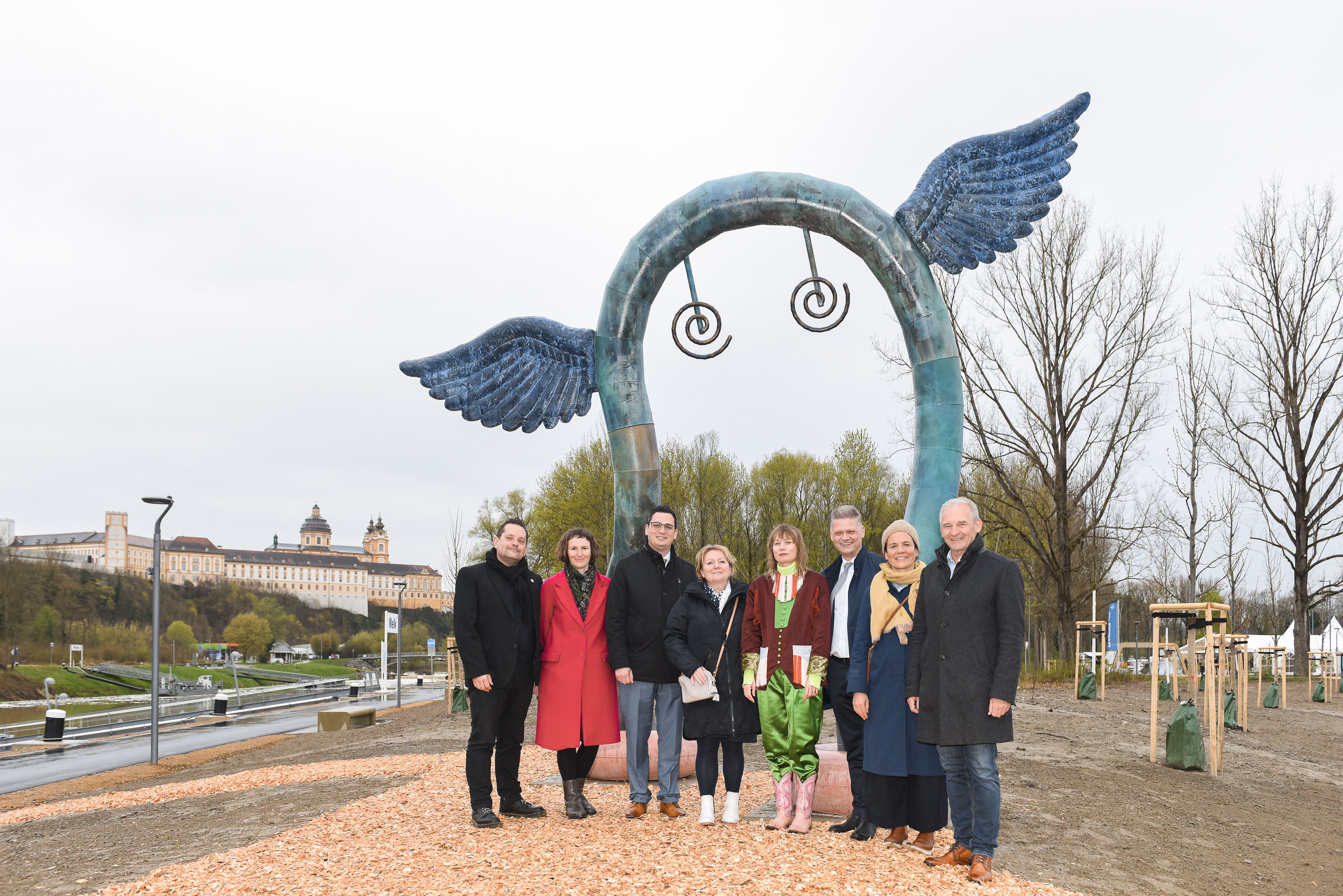Kris Lemsalu
:
DOORA
Back
Information
The artist Kris Lemsalu (born 1985), who lives and works in Tallinn, Estonia, and New York, created an oversized, site-specific sculpture for the Spitz, the point of land on which the harbor lies, in Melk. In her artistic practice, she weaves sculptures, installations, and environments into multifaceted narratives that create links between history and the present day, while condensing mythologies, rituals, and stories into new constellations. With her sculptural ensemble on the Danube—a river that connects many cultural areas—Lemsalu addresses the question of how different cultures and forms of society are reflected within each other.
Lemsalu works with traditional production processes from handicraft, while also sounding out the limits of sculpture and its crossovers into performance and music. She mixes these with the contemporary artistic media of ceramics, textiles, and metal, referring to the language of materials that have been used for icons, idols, constructions, cladding, and covers since pre-historic times.
The sculpture DOORA stands between the Danube and the Melk tributary like a lighthouse and functions as a mirror of our imagination. In preparation for this project, Lemsalu did research in Melk and its surroundings, and she developed her design on-site. The sculpture was realized by a large team—Lemsalu’s extended studio—in Tallinn and Vienna, where she studied at the Academy of Art. She drew inspiration for this multifaceted work from ornamental illuminated manuscripts from the library of Melk Abbey, as well as the ceramic sculpture of an ambivalent figure between human and animal—a hybrid between bird and human—from the Neolithic period that can be seen in the Museum of the City of Melk today, and the Venus of Willendorf, which was discovered in 1908 in the area around Melk and which was created about 30,000 years ago as a ritual Venus figure.
The symbol of Venus connects different times with a collective feminist attitude. Shortly before her death, the avant-garde writer Anaïs Nin (1903–1977) published a collection of erotic stories she wrote in the 1940s under the title Delta of Venus, which was a reference to the shape of the vulva. Lemsalu adopts this metaphor and animates the form of the Venus in her sculpture. The Venus is a motif that she has interpreted in several of her other works as well, albeit from a variety of perspectives. With her personal, humorous, and poignant gesture, Lemsalu positions the Venus as a symbol of feminism and matriarchy—a form of society that is organized around the mother and is free of institutional hierarchies—in front of the baroque backdrop of the Benedictine Melk Abbey, a patriarchal institution. The artist thus sketches a picture of the transformation of this female allegory, thereby shifting the patterns between genders. In her self-portraits, she often shows herself with male and female features to present a fluid reality.
Baroque as the name for a historical period comes from the Portuguese word barocco, which was originally used in the art of goldsmithery and means “irregular pearl.” Lemsalu has a special affinity for materials. The sculpture DOORA develops its sway from a tube made of steel clad in copper foil. The painterly surface covered by a glaze of iron oxide, as used in ceramics, shimmers in different shades of blue, depending on the light and the viewer’s perspective, seeming to answer the color of the river or the patina of the dome of the monastery, which is clad in copper.
All parts of the sculpture, with its organic form, its clear outlines, and its sign-likeemblematic attachments, are either visually, imaginatively, or actually in motion. The form of the sculpture expands into two- and three dimensional space, like an instrument, by swinging and twisting its body. Its eyes, which turn in the wind, are derived from the form of the spiral, similar to the circles that emerge when a stone is thrown into the water.
The outline of the sculpture changes when you approach it, says the artist. Thanks to the torsion of the curved form, when we walk around it, we see a constant change in perspective unfolding in front of our eyes. While DOORA implies motion, it also opens up into an arch that invites us to pass through it and delve into our imagination. DOORA was “activated” by the artist in April 2022 at the opening together with the Estonian Jazz sax player Maria Faust, who gave the sculpture a voice that sounded as if it came from the inside of a ship.
Lemsalu developed the figure to have wings. In a similar way to the sculptor Henry Moore (1898–1986), who was interested in nature and its phenomena and addressed the theme of flying in his sculptures as well, Lemsalu chooses natural phenomena and forms as models. When there is flooding, which can also reach the city, the concrete swim rings with their fishtails let the sculpture glide over the water as if it were wearing in-line skates, while its eyes act as points that guide us. The ornamental pair of wings refers to the narrative of the ancient winged figure Nike, lending DOORA balance and letting her fly.
The sounds, the motif of the spiral, and the performative torsion of the sculpture reflect the motion and ambivalence of the river. The Danube flows into the Black Sea through the delta after the city of Vylkove in Ukraine. The sculpture is a sign.
Bärbel Vischer









